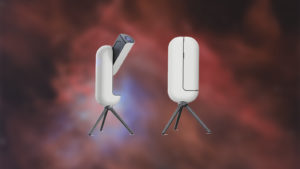Thabet Al Qaissieh built an observatory as a hobby and is now working with one of the most prestigious universities in the world.

Emirati astronomer Thabet Al Qaissieh built Al Sadeem Observatory at his family’s farm in Al Wathba. Antonie Robertson / The National
An Emirati amateur astronomer who built an observatory on his family’s farm is collaborating with NYU Abu Dhabi on research into black holes.
Images taken at Thabet Al Qaissieh’s Al Sadeem observatory in Al Wathba are helping to verify if a new system discovered in March contains a black hole.
The “black hole candidate” is about the size of Abu Dhabi, one of the brightest discovered in years and is about 10,000 light years from Earth. That’s close in astronomical terms, although too far to affect Earth. But this research could help if one day a black hole turns up next door.
David Russell, an assistant professor of physics at NYUAD, is leading the university’s research team.
“When this system developed and became really bright, we thought let’s observe this with a telescope. I contacted Sadeem… and we started getting fantastic data,” he said.
According to Prof Russell, it’s 90 per cent certain that the system is a black hole, but more research is needed. Other telescopes around the world are also being used.
“It feels surreal,” Mr Al Qaissieh said of the joint effort with NYUAD. “We are working with top-notch scientists to study objects beyond my wildest imagination. If all goes well, it could be something we contribute to space discovery.”
Black holes form when a massive star collapses on itself and then starts to suck in nearby stars. Scientists can’t see black holes because not even light can escape their pull, but they can observe what’s happening to nearby stars as they hit the black hole. It is believed that when the universe was very young, black holes affected how galaxies formed. The system, known as MAXI J1820, was first spotted by an X-ray telescope on the International Space Station, but Prof Russell’s team were the first to think it could contain a black hole.
“The images from Al Sadeem allow us to study both the hot gas plummeting into the black hole and also some matter that escapes in the form of jets that travel… close to the speed of light,” Prof Russell said.
The decision to build the observatory was born out Mr Al Qaissieh’s passion for stargazing. The 36-year-old grew up in Al Ain in the 1980s and can still recall the beauty of the night sky during trips to the desert with his father. He wanted to look at the Moon with a telescope, and a conversation with his late brother, Mansour, also proved decisive. “He [Mansour] said: ‘Listen, it’s simple: if it works then it’s something great for community. And if it doesn’t, you have a nice place to hang out’.”
Mr Al Qaissieh’s brother died in 2015 and Al Sadeem opened a year later with the help of Alejandro Palado, a Filipino expatriate who founded the Abu Dhabi Astronomy Group. The dome was imported from Poland and protects the Meade telescope. Low levels of light pollution also help. A metal sculpture inspired by an astrolabe sits at the entrance in honour of Mansour.
Mr Al Qaisseh still has a day job looking after the family business, but Sadeem, which is the Arabic word for “nebula”, has now hired a full-time astronomer, hosts students, holds outreach programmes and conducts research. What started off as a hobby has developed into an academic collaboration with one of the most respected universities in the world.
“I was pretty excited,” Prof Russell said of his first visit to Al Sadeem. “At NYUAD, we have the biggest group of astronomers in the country, but there were not many local facilities. When I found out there was this telescope… I was very impressed by the set-up.”
When The National visited on a clear Tuesday night, Mr Al Qaissieh is easily able to pick out Jupiter and Saturn in the night sky. It’s a skill that has been lost as younger generations rely more and more on technology.
“Fifty or 60 years ago, many people who went from Abu Dhabi to Al Ain used the sky,” he said. “They didn’t use GPS or have a nice road with lights. Even today in the military, you are required to know basic star positions for guidance.”
Compounding this is the fact the Arab world was once a pioneer in astronomy. But the UAE Space Agency was established in 2014 and the Emirates Mars Mission aims to place a probe named Amal (“Hope”) into orbit around the Red Planet by 2021. The conditions to allow Emirati and Arab scientists to flourish are being created again – something Mr Al Qaissieh sees first-hand through his outreach programme.
“There is this idea that Arabs or Muslims are anti-science,” Mr Al Qaissieh said. “But the amount of young Arabs we see is super impressive. Especially the women. Us guys are way behind our female colleagues in this field.
“It’s also about changing the perception of the UAE and wider region that has been plagued by problems. It’s just wasted energy and that’s one of the most important messages the UAE sends out with the Mars probe.”
For now, 50 images a day are being sent by Sadeem on the system and an academic paper is expected in the forthcoming months. Emirati students at NYUAD are also helping with the project and gaining vital experience.
“No one has studied how the optical variations of a black-hole system like this one change during the whole outburst,” Prof Russell said.
“Our studies are therefore unique and at the cutting edge of black-hole research and will help advance our understanding of these kinds of objects.”




